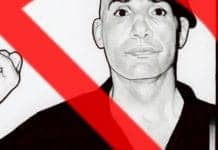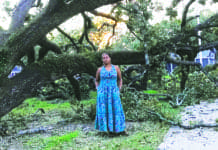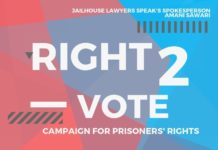
by Amani Sawari
On Dec. 4-6, organizers, activists, students, professors, reformists and abolitionists from across the spectrum convened at the University of Mississippi’s Oxford campus to discuss the outcomes of America’s deadly sin at the Making and Unmaking Mass Incarceration (MUMI) Conference. With a diverse panel of inspirational and highly qualified speakers over a series of agenda packed days, the event united great minds and aspiring revolutionaries in order to tackle the plethora of complexities that exist within America’s criminal legal system.
The keynote address by Albert Woodfox of the Angola 3, framed around his new book “Solitary,” was the perfect way to kick off the conference. His experience of 40 years in solitary confinement informed the many students in the audience of the extent to which corrections departments go to dehumanize people. Audience members were inspired and motivated by the courage and determination that Woodfox and his peers demonstrated in their many fights to be recognized as human beings while incarcerated in Angola Prison, changing policies that impacted the way that they were served their food to the way that they were stripped searched.
Overall, the conference highlighted the undeniable role that many public universities, including Ole Miss, played in building the prison industrial slave complex and continue to play in maintaining it.
What do universities owe people who are incarcerated and formally incarcerated?
Historically, access to academia has been viewed as a privilege that prisoners did not have the right to, simply due to their incarceration status. In order to combat this, institutions of higher education would need to seek out students in the prison and be intentional about working with state and federal departments of corrections to offer their programs to incarcerated students at an affordable cost.
Institutions with this type of initiative continue to be few and far between. During the University and the Prison panel, Syrita Steib-Martin, executive director of Operation Restoration, explained that for decades the Baptist Theological Seminary, which targeted lifers as students to become ministers, was the only higher education opportunity offered to prisoners in Louisiana. Programming that would inspire critical thinking was not encouraged. This history perfectly illustrates the intention of the college, in partnership with DOC, to value the education of prisoners only when that education serves to further sedate the population, not to empower them.
Thankfully, more recently, colleges and universities have begun to offer programming in their local penitentiaries. Programs like University Beyond Bars offer college degrees to incarcerated students at Washington State Reformatory and Monroe Correctional Complex through Seattle Central College. However, access to accredited college programming in prison is still an anomaly.
With the passage of the 1994 Crime Bill’s restrictions on Pell Grant provisions for incarcerated people, access to academia has continued to dwindle. With limitations on Pell Grant funding for prisoners, the burden of responsibility falls solely on the student to pay their tuition, making obtaining an associate or bachelor’s degree while in prison virtually impossible. Understanding that limited educational opportunities are a chief contributor to incarceration, it is imperative that we dramatically increase the number of educational programs offered to people while in prison.
Unfortunately, academia in our state prisons is currently predatory, as many formerly incarcerated students are unable to complete the degrees that they began while incarcerated after their release due to restrictions on them as former felons from the colleges they attended while incarcerated. Michelle Jones, a third-year doctoral student in the American Studies program at New York University highlighted this problem, saying that the university owes its formerly incarcerated students “continuity of a college experience that is quality … and a clear pathway to completion.”
Jones emphasized that any program marketed as a “college course” should culminate in the “conferral of a real credential.” Courses that do not supply credits should be marketed as extracurricular.
Jones also stressed the fact that educators coming into the prison must embrace their students’ experience of incarceration throughout their study. As a caution, for educators entering the prison, there must be an understanding of the false autonomy that many wardens have.
Wardens often choose to limit a student’s access to education as punishment. Out of a responsibility to their incarcerated students, educators must be confident in challenging this false autonomy and be empowered to push back on administration in order to protect the quality of the education being provided to their students.
Educators should also be open to extending beyond the divisions enforced by the prison by co-collaborating with students who are serving life sentences and virtual life sentences, many of whom are deemed ineligible by DOC to participate in educational programming. Educators coming into the prison must enforce their natural, true autonomy over their classes in prison in the same way that they are comfortable doing so at any other institution of higher education.

Legacies of slavery
During my presentation, I focused on the trends we’ve seen in politics throughout 2019, mainly in response to the 2018 National Prison Strike that birthed the ongoing New Suffrage Movement. It was important for me to illustrate how the increase in outside participation in 2018 amplified the strength of people’s participation on the inside.
This direct relationship between outside support and inside action is one that we must continue to strengthen. My goal is to connect outside organizers, especially student groups, with inside organizers for guidance and support with upcoming actions.
The need for this was further emphasized during a presentation by Dan Berger, an author and associate professor of comparative ethnic studies at my alma mater, the University of Washington. Berger shared a voice recording from Stevie Wilson, an organizer incarcerated in Pennsylvania who explained to attendees that participants in the prison resistance movement are like the “two wings of a bird” – the inside organizer is one wing and the outside organizer is the other. “If you’re not connected with someone on the inside right now, you’re wrong,” Wilson declared.
This metaphor resonated deeply with me, and many others repeated it throughout the conference. As the days continued, I was approached by several student groups that were eager to propel forward in their prison resistance work by connecting with inside organizers. Through the Right2Vote Report I’m able to quickly locate and identify potential connections between these groups and my readers, all of which I consider inside activists in their own right, ready for the opportunity for outside collaboration. This is why I am eager to expand the Right2Vote Report’s subscription base as well as attend events like these to assist in making those connections. There are multiple ways that student groups can support prison resistance with the resources available on their campuses.
How do we involve the people of the university as well as the university as an institution in abolition?
Colleges and universities are seen as sites for movement building, but this depends on the people within the institution, not the institution itself. I concur that the university plays an essential role in the abolition of prisons, but the university is an institution so we have to think about what roles people within that institution have in the prison resistance movement.
As Right2Vote transitions into a multi-year campaign, we are focused on helping students identify their role in the prison resistance movement using the resources available at their college by supporting students in establishing a variety of prisoner support groups depending on the students and their institution’s orientation to the Prison Industrial Slave Complex (PISC). Some institutions may have a deep historical connection, like with the University of Mississippi’s relationship with Parchman Prison.
Other universities, like the University of Washington, may have direct connections to the PISC through state policy. For example, Washington State has passed legislation that requires the university to purchase products from Correctional Industries, which employs Washington state prisoners at slave labor wages.
With these types of relationships still operating between our prisons and colleges, our universities owe prisoners more than just access to college credits. In addition to providing accredited college courses to prisoners, students can support prisoners in a number of ways through forming student groups with a focus on improving prison conditions.

Prisoner Research Aid Group
One of the simplest ways for student groups to support prisoners is through initiating a Prisoner Research Aid Group. This would be perfect for law, English, sociology or arts majors but is a simple form of support any type of student can easily get started.
Prisoners are constantly in search of materials that aren’t readily available in their law library. Students can form a research aid group to support prisoners in their state by providing reading materials to prisoners by request. Prisoners need help accessing articles, bills, legislation and other documents that are imperative to their study, and students have access to large data basis that usually go underutilized for the majority of their college career.
These types of groups should exist at colleges to support prisoners in every state. It can be done by simply creating an email account for digital correspondence via JPay, CorrLinks or any available system and having a post office box for snail mail correspondence. As students receive requests for different types of documents or portions of books, they can simply fill those requests by printing, scanning, copying and pasting the necessary material and mailing or emailing those documents to the prisoners who’ve requested them.
There’s nothing “too” radical about initiating a Prisoner Research Aid Group for students who may be on the fence afraid to lean too far. This group guarantees equal access to information, a human right of every person regardless of their incarceration.
Students involved in this group who are interested in going deeper may also get involved in a research project to support those incarcerated in their local prison. Types of projects could include budget assessments to support reform policies or case studies for individuals who’ve been over-sentenced or wrongly convicted.
Prison Divestment Group
As an alternative to the more neutral group described above, students who’ve identified connections between their university and prison slavery have formed prison divestment groups in order to call on their college to divest from the use of prison labor. This is one of the more popular methods that students can use to support incarcerated citizens suffering from labor exploitation in their state. For example, at Harvard students formed the Harvard Prison Divestment Campaign calling on the university to pull out of their prison contracts so long as imprisoned employees are paid slave labor wages.
There are hundreds of public institutions that maintain the use of prison slavery through mandating that these companies employing prisoners be used to supply furniture, food, construction and other products. These institutions do so usually through a lack of transparency.
There is a growing movement of students who have identified these draconian policies and are calling out their campuses. The establishment of divestment groups propels progress towards paying prisoners fair wages. Knowing that it is the student’s tuition dollars that pay these costs, it is the students’ responsibility to oversee the use of those dollars.
Prisoner Program Support Group
Prisoner Program Support groups are already in full swing. Hundreds of religious groups as well as arts and book clubs have outside members who go into the prison regularly for to provide programs.
I would like to see more students take advantage of the opportunity to participate in prisoner programs that allow outside community members to go into the prison. I’ve been involved in multiple prisoner programs that went inside, including a poetry program and the Black Prisoners Caucus, in both of which I was the youngest outside attendee. Prisoners are fueled by interacting with young, passionate people.
These types of opportunities to go inside are rare, so we must take full advantage when they are presented. Some colleges have programs or events that allow students to go into the prison on a regular basis in support of an on-campus religious, cultural or arts program.
I encourage students to seek out these types of programs and events or to create their own. Prisoners meet on the inside regularly for book clubs, poetry reading, strategizing policy and other types of conversations that I’m sure they would be more than happy for outside participants to contribute to.
This may be one of the more difficult types of groups to organize so it may be helpful to start off with establishing a research group or divestment group over the months it may take to plan and organize an inside program. Establishing an inside program would require the most amount of interaction with DOC staff.
Programs can be regular – weekly, monthly or quarterly – or can be a one-time event. Regardless of the frequency, maintaining communication with inside organizers is essential throughout the planning and implementation of the program or event.

Prison Abolition Group
Finally, one of the more controversial, yet powerful groups would be a student Prison Abolition Group. Students involved, like those in the Research Aid Group, would be guided by the requests of those prisoners they are supporting.
However, rather than solely fulfilling requests for copies of documents, students in the Prison Abolition Group would be responsible to prisoners for supporting legislation proposed by their incarcerated comrades. This student group could go by a series of other names like prisoner policy support group, prison condition improvement group, or criminal justice reform focus group.
Regardless of the name, this student group would be a prisoner support group that would have an abolitionist focus in the legislation they advocate for. Student advocacy is powerful in politics so it’s essential that students’ voices are involved in advocacy for legislation committed to prisoners’ human rights.
It may be difficult for organizers to decide which proposals for legislation to support. During the conference, Mariame Kaba, an organizer, educator and founder of Project NIA, provided attendees with a series of guiding questions to use in our advocacy of reforms including:
- Does it provide material relief?
- Does it leave out any marginalized people?
- Does it legitimize or expand the system we fight against?
- Does it transfer power?
- Does it divide people into deserving vs. underserving?
- What are the logistics that initiatives enforce?
- Does it liberate? Or oppress?
- Is it punitive?
Kaba used the example of police officer body cams that activists advocated for in California. These cams, contrary to popular belief as a “helpful” reform, fail questions 1, 3, 4 and 7 by transferring more power to the criminal legal system that we fight against and by further oppressing marginalized people who continue to suffer from police brutality. Prison Abolition Student Groups, as well as all reformist organizers alike, should review these questions prior to the initiation of any campaigns so that we do not misdirect energy on policies that will lead to further harm in our communities.
When’s the next MUMI?
Garrett Felber and his team at the University of Mississippi did an incredible job organizing this groundbreaking event. I am honored to have been invited to speak, to uplift the work of Jailhouse Laywers Speak and to have connected with inspiring organizers and academics in this field, many of which I’ve been following on social media since my college graduation a few years ago.
As a student, I did not recognize my authority on campus to create movements on behalf of incarcerated people in my state, but with this conference that realization was solidified for hundreds of current students. Regardless of one’s status as an activist, ally or academic, everyone should have a critique of the carceral state.
For students who do consider themselves activists or abolitionists, this is the next step, to form a group of like-minded individuals on your campus that can build on the work of prison resistance in your state. The resources are there, the people – on both sides of the wall – are ready and I am happy to make a trip to visit any student group that needs help at any phase in establishing a collaborative prisoner support group.
There is great potential for a national initiative of students collaborating on campaigns in support of prisoners’ human rights. These student groups can organize the next MUMI conferences on their campuses for years to come.
I’m ready to put the next five years of conferences on the calendar!
Amani Sawari is currently coordinating the Right2Vote Campaign, the national new suffrage movement to restore the voting rights of probationers, parolees and prisoners across the country. Campaign updates can be found in the Right2Vote Report. Incarcerated supporters can request to be added to the mailing list by simply contacting Amani Sawari @Sawarimi on social media, by email at amanisawari@gmail.com or by mail at P.O. Box 2278, Detroit, MI 48202.

 Store
Store












